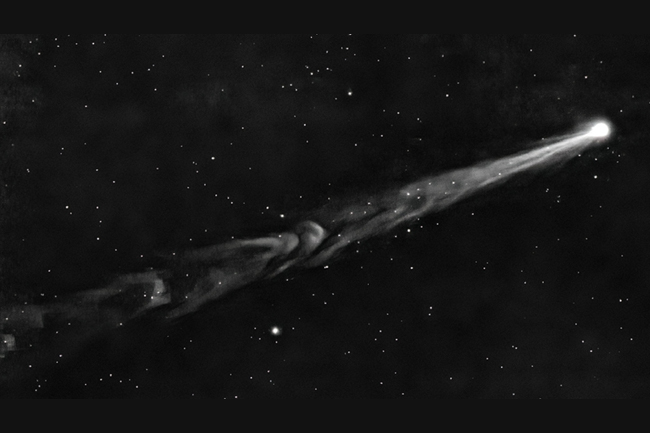Pasadena, Gatra.com- The green dragon from ‘heaven’ glided through space towards the sun. His journey across four centuries was discovered by amateur astronomer Hideo Nishimura. The dragon’s mighty tail was swept up by the solar storm as it darted and danced around the Sun.
The universe ballet was performed by comet Nishimura after surviving being hit (closest distance) by the Sun. Comet Nishimura was hit by a jet of coronal material which severed its tail. This rare event was captured by a NASA spacecraft.
An unexpected collision that blew away the comet’s tail caught on camera NASA space shuttle. In footage taken by NASA’s Solar Terrestrial Relations Observatory (STEREO-A) spacecraft, a plume of plasma hits Nishimura and “jostles” around the comet’s tail – a stream of dust and gas carried by the sun from the comet – before completely breaking it off, Karl Battams, an astrophysicist at the United States Naval Research Laboratory who created it video the event (shown above), told Live Science via email.
Comet Nishimura, also known as C/2023 P1, was first seen falling rapidly toward the sun on August 12 by Japanese amateur astronomer Hideo Nishimura. Its steep trajectory initially suggested it might be an interstellar object, such as ‘Oumuamua or Comet 2I/Borisov, which would leave the solar system after it hurtled around the sun.
But follow-up observations revealed that the comet originates in the Oort Cloud – the source of comets and other icy objects beyond Neptune’s orbit – and has a highly elliptical orbit that takes it into the inner solar system roughly every 430 years.
On September 12, Comet Nishimura reached its closest approach to Earth when it passed within 78 million miles (125 million kilometers) of our planet, or roughly 500 times the average distance between Earth and the moon. In the days leading up to this event, the comet was clearly visible near the horizon shortly before sunrise and immediately after sunset, which made for some stunning photos of the icy object streaking across the night sky. In some of the photos, Nishimura emits a green glow due to the high concentration of dicarbon in the cloud of gas and dust, called a coma, that surrounds its rock core.
On September 17, the comet reached its minimum distance from the sun, known as perihelion, as it hurtled around our home star at a distance of 20.5 million miles (33 million km). Close encounters like these can often cause comets to burn up and break apart. But astronomers soon discovered that Nishimura survived the scorching high-G maneuver.
As Nishimura began flying away from the Sun, it passed in front of STEREO-A, which was keeping a close eye on the runaway comet. Then on September 22, the sun ejected a massive wave of plasma, or ionized gas, that came from a powerful burst of solar wind or CME, Spaceweather.com reported.
CMEs decapitate comets in so-called disconnection events. The effect was only temporary and “completely harmless” to the comet, Battams said. After the disconnection event, the comet’s tail will grow back – like a lizard’s tail – because more dust and gas is blown out of the comet.
This is not the first time Nishimura has lost his tail. Earlier in September, a pair of CMEs hit a comet, causing at least one disconnection event, a sister site Live Science, Space.com, reported. But despite being constantly bombarded by solar storms, the comet “behaved surprisingly well” and remained on its original trajectory, Battams said.
For most people, the comet will likely not be visible to the naked eye again before returning to the Oort Cloud. However, unless the city “randomly breaks apart” in the next few weeks and months (which is likely), “there seems a good chance that people a few centuries from now will be able to enjoy it again as the comet passes through the neighborhood, Battam said.
33
2023-10-01 23:26:19
#Wonderful #Green #Dragons #Tail #Heaven #Breaks #Solar #Storm #Grows #Lizards #Tail #Technology


